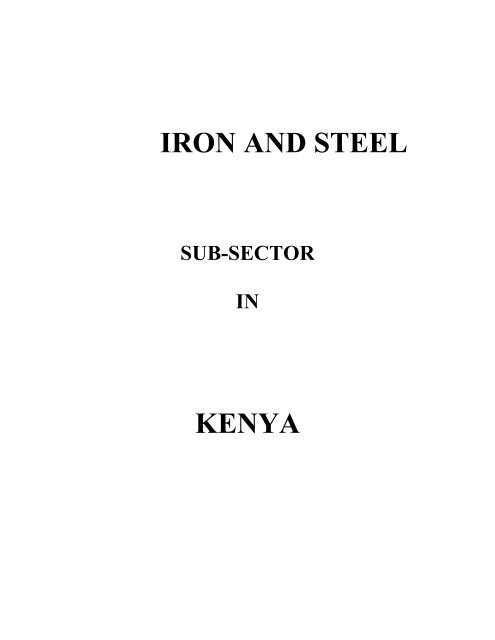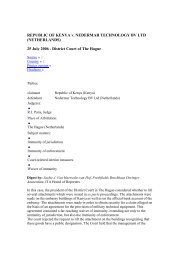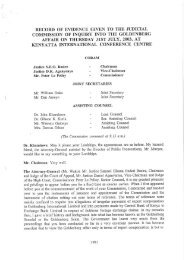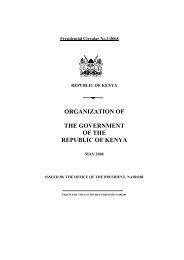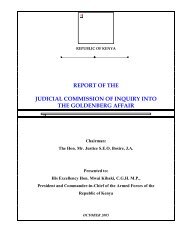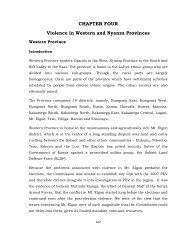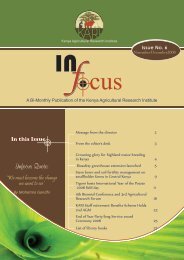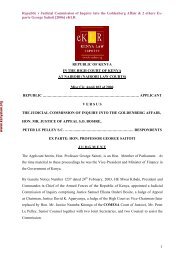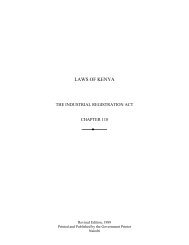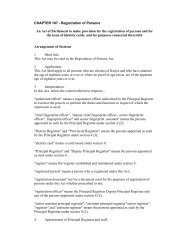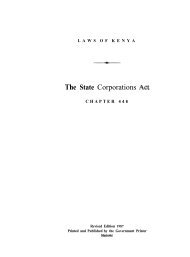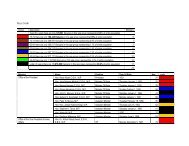IRON AND STEEL KENYA - Mars Group Kenya
IRON AND STEEL KENYA - Mars Group Kenya
IRON AND STEEL KENYA - Mars Group Kenya
You also want an ePaper? Increase the reach of your titles
YUMPU automatically turns print PDFs into web optimized ePapers that Google loves.
<strong>IRON</strong> <strong>AND</strong> <strong>STEEL</strong><br />
SUB-SECTOR<br />
IN<br />
<strong>KENYA</strong>
TABLE OF CONTENTS:<br />
1.0 INTRODUCTION 3<br />
2.0 PRODUCTION OF <strong>STEEL</strong> IN <strong>KENYA</strong> 3<br />
3.0 OVERVIEW OF SECTOR 4<br />
4.0 DEVELOPMENT OF <strong>IRON</strong> & <strong>STEEL</strong> SECTOR BEFORE<br />
LIBERALIZATION 5<br />
4.1 POST LIBERALIZATION 5<br />
5.0 MARKET DEVELOPMENT 7<br />
6.0 RAW MATERIAL DEVELOPMENT 9<br />
6.1 SCRAP METAL 9<br />
7.0 INVESTMENT OPPORTUNITIES 10<br />
8.0 CONSTRAINTS FACING THE INDUSTRY 11<br />
9.0 THE FUTURE OF <strong>IRON</strong> <strong>AND</strong> <strong>STEEL</strong> INDUSTRY IN<br />
<strong>KENYA</strong> <strong>AND</strong> STEPS TO BE TAKEN FOR IT’S SERVIVAL<br />
<strong>AND</strong> GROWTH 15<br />
9.1 FIRM LEVEL ACTIONS 15<br />
9.2 ACTION AT GOVERNMENT LEVEL 16<br />
10.0 RECOMMENDATIONS ON RAW MATERIAL 17<br />
11.0 THE WAY FORWARD FOR <strong>IRON</strong> & <strong>STEEL</strong> INDUSTRY 18<br />
2<br />
Pages
1. INTRODUCTION<br />
Steel is the backbone of the economic activity of any country. The per capita steel<br />
consumption is an internationally recognized indicator of the level of<br />
development of that country. Direct and indirect consumption of steel in <strong>Kenya</strong><br />
was projected to be 0.567 – 0.614 million tons in the year 1985 and 1.860 – 2./356<br />
million tons in the year 2000. On the basis of the above projection the per capita<br />
steel consumption in <strong>Kenya</strong> was expected to increase from 20 – 25kg in 1985 to<br />
45 – 50kg of iron and steel by 2000.This can be compared to 798kg in USA and<br />
915kg in Japan in 1985 as per a report by UNIDO.<br />
Industrial progress and economic well being are reflected in such physical<br />
development as housing, transport facilities, water distribution, industrial<br />
premises including warehouses and office space, agricultural mechanization,<br />
leisure facilities, healthcare facilities and many others.<br />
The Iron and Steel industry formed 13 percent of the manufacturing sector, which<br />
in turn contributed around 13 percent of the GDP. The Iron and Steel sector is<br />
mainly controlled and owned by the private sector of <strong>Kenya</strong>n Asians unlike in<br />
many countries where the Iron and Steel sector is public owned or government<br />
controlled.<br />
The <strong>Kenya</strong>n private sector has over the years invested over Kshs. 5 Billion in<br />
fixed assets for the production of various Iron and Steel products. The industry is<br />
heavily dependent on imported raw materials, as no local sources have been<br />
developed to date. Local deposits of iron ore have been identified in several<br />
locations but have not attracted commercial interest. Through imports of raw<br />
materials and local scrap collection, a sizeable and a growing local capacity has<br />
developed to cater for both export and domestic market.<br />
From the basic iron and Steel industry a diversified network of downstream<br />
industries has emerged. These downstream industries include Motor Vehicle and<br />
Auto-ancillary, a range of fasteners, reinforcement bars for construction,<br />
furniture, agricultural tools, kitchen ware etc.<br />
2.0 PRODUCTION OF <strong>STEEL</strong> IN <strong>KENYA</strong><br />
Steel production is generally divided into two categories- primary and secondary<br />
productions. Two alternative process routes for primary production are in use,<br />
namely: 1. BLAST FURNACE ROUTE and 2.SPONGE <strong>IRON</strong> ELECTRIC ARC<br />
FURNACE ROUTE. In the first case processed iron ore is smelted in the Blast<br />
Furnace to produce liquid steel (Pig Iron), which in turn is cast into semi finished<br />
products (Semis) like Billets, Hot Rolled Coils, Ingots, Plates etc. In the second<br />
process route iron ore is heated in combination with gaseous reductant to produce<br />
3
sponge iron (Direct Reduced Iron- DRI) in solid state. The sponge iron is then<br />
smelted in an Electric Arc Furnace and then cast into Semis as in the first case.<br />
The activities of Secondary Production on the other hand involve either smelting<br />
of scrap metal in an Electric Arc Furnace to produce semis OR rolling of the<br />
semis into sheets, rods, sections, angles, etc.<br />
In <strong>Kenya</strong>, the existing iron ore deposits have not been commercially exploited<br />
hence the manufacturing activities in this sector is classified under Secondary<br />
production. Locally sourced scrap metal is smelted in the existing Electric Arc<br />
Furnaces to produce steel billets or ingots. The billets are further rolled into<br />
reinforcement steel bars for use in construction industry.<br />
For the production of special products like screws, bolts and nuts, nails, rivets etc,<br />
the local steel mills have to import quality billets arising from the primary<br />
production route. Other production activities involve importation of Hot Rolled<br />
Coils, for re-rolling into Cold Rolled coils, which are in turn processed into<br />
galvanized sheets, and colour coated sheets.<br />
The country will be able to produce such semis as Hot Rolled Coils, Special<br />
billets, plates etc (currently being imported) if the existing iron ore can be<br />
exploited so as to start producing sponge iron.<br />
3.0 OVERVIEW OF THE SECTOR.<br />
<strong>Kenya</strong>’s iron and steel industry can be classified into five categories in<br />
accordance with the products manufactured. These are:<br />
steel making and hot rolling<br />
wire and wire products<br />
galvanized and cold rolling steel coils<br />
pipe manufacture<br />
castings.<br />
The major products under the steel smelting and hot rolling process are pencil<br />
ingots billets, wire rods, rounds, section channels and reinforcing bars. The major<br />
enterprises involved in the production of these items are ROLMIL (<strong>Kenya</strong>) Ltd,<br />
City Engineering Works Ltd, <strong>Kenya</strong> United Steel Company etc. The total steel<br />
rolling capacity in the country is about 600,000 tonnes per year, while total<br />
smelting capacity is about 95,500 tonnes.<br />
There was only one enterprise, Special Steel Mills in Ruiru, which produced wire<br />
rod and wires that were used by about nine enterprises for further processing into<br />
other wire products such as nails rivets, nuts, bolts, barbed wire, chicken wire<br />
mess, fencing wire and other wire products. The firm however has collapsed,<br />
forcing down stream industries which used to rely on wire products to import the<br />
same from the international markets.<br />
4
The products manufactured from galvanized and cold rolling steel coils, are<br />
galvanized corrugated iron sheets, steel drums, window louvres, wheelbarrows,<br />
gutters and water pipes. There are two cold rolling plants with installed capacity<br />
of 204,000 tonnes per annum. The two firms are Mabati Rolling Mills Ltd and<br />
Standard Rolling Mills Ltd.<br />
Six firms manufacture large and small diameter, circular and square pipes for use<br />
in such activities as water distribution, sewage disposal and furniture<br />
manufacture. The products of the casting enterprises are man-hole covers,<br />
sanitary fittings, pumps, castings and impellers, pulleys and sugar crushing<br />
rollers.<br />
There are about 16 major foundries with a total installed capacity of 8,500 tonnes<br />
per year.<br />
The sector has continued to face stiffer competition from imported steel products,<br />
mainly originating from Eastern European countries. Most of these industries<br />
receive considerable amount of government support in the form of state subsidy<br />
e.g tax-free power, water and other utilities. This is an aspect of dumping and has<br />
led to the closure of many steel industries in <strong>Kenya</strong> including, Special Steel Mills,<br />
Emco Steel Billets, Emco Steel Works, and partial operation of others like Morris<br />
and Company Ltd.<br />
4.0 DEVELOPMENT OF <strong>IRON</strong> <strong>AND</strong> <strong>STEEL</strong> SECTOR BEFORE<br />
LIBERALIZATION<br />
Since the early 1950s, the <strong>Kenya</strong> steel industry has gradually developed new<br />
branches and integrated backwards, making more of its raw materials. The<br />
industry started by making nails, moved into drawing wires, and later made<br />
wirerods. The manufacture of steel sections and reinforcing bars also led to steel<br />
melting and local manufacture of steel ingots, continuous casts billets, and<br />
refractory bricks for melting furnaces.<br />
In the case of flat products the industry started by galvanizing steel sheets and<br />
later by cold rolling imported hot rolled coils for galvanizers and wheelbarrow<br />
manufacture. Various firms manufacture pipes and fabricate many metal products.<br />
<strong>Kenya</strong> cannot yet make heavy forgings, smelt iron ore, make tin-plate, hot rolled<br />
coils, heavy sections, wide flat products and seamless pipes due to technological<br />
constraints and low local demand. However, for secondary products the country<br />
has advanced and gone much beyond simple consumer goods import substitution<br />
and has developed a basic industry with considerable backward integration.<br />
5
The industry’s growth occurred with occasionally intense- but behind the sceneseconomic<br />
conflicts and political lobbying. Many industrialist started by<br />
controlling commercial out-lets for steel products and only later began to<br />
manufacture steel products. During the transition, temporary monopolies and<br />
oligopolies formed to charge buyers for often-undependable supplies. This led<br />
some buyers to integrate backwards to escape that dependency. This pattern of<br />
defensive investment still motivates much of the industry’s investment and<br />
individual users of the semi-finished products have often continued importing just<br />
to avoid buying from their local counterparts.<br />
The government failed to guide the industry’s development and overtime the<br />
absence of coordinated development encouraged conflicts between entrepreneurs<br />
leading to a massive build-up of excess productive capacity. This inefficient<br />
investment led to high prices, hindered export, and tied up resources, which<br />
would have been invested elsewhere.<br />
4.1 POST LIBERALIZATION<br />
4.1.0 Positive Effects<br />
♦ Raw material sourcing has become very easy whereby one can source the quality<br />
raw material any where at the most competitive price, thus eliminating the need<br />
for import licensing and the associated bureaucracy<br />
♦ Foreign exchange has become more accessible and lead-time for raw materials<br />
considerably reduced. This has brought some savings in raw material stock<br />
holding (in actual investment, godown, space and handling costs) hence making<br />
things move faster right from the raw material acquisition to finished goods<br />
dispatch, to the advantage of all concerned.<br />
4.1.1 Negative Effects<br />
♦ The process has created a lot of competition from direct imports of steel products<br />
and mushrooming of small uneconomical mills across the country.<br />
♦ The impact has put great pressure on the manufacturers, which has forced them to<br />
observe high quality standards of for the products so as to compete with direct<br />
imports from elsewhere and at the same time pricing such products competitively.<br />
♦ Dumping of steel products into the local market is probably the most serious<br />
impact of liberalization as this led to the closure of many steel plants in the<br />
country, with the consequence of loss of jobs.<br />
♦ The <strong>Kenya</strong>’s traditional neighbouring markets, Uganda, Tanzania, Rwanda,<br />
Burundi, etc. Are systematically reduced due to imports from the same above<br />
mentioned non-COMESA member countries.<br />
6
5.0 MARKET DEVELOPMENT<br />
5.1 Internal Market<br />
Most of the products emanating from our steel mills are locally consumed in the<br />
fields of construction, metal fabrication to make various industrial equipment,<br />
agricultural implements, domestic appliances motor vehicle assembly parts etc.<br />
This scenario arose by design as most plants were set up with a view of meeting<br />
only local demands. This inward looking strategy coupled with high protection in<br />
the days of import substitution encouraged plants to continue amassing massive<br />
profits despite inefficiencies in their production runs.<br />
It is important for steel industries to realize that the honey moons of import<br />
substitution is long gone and that for a sustainable development of the sector in a<br />
free market economy, they will have to go an extra mile in developing both local<br />
and external markets for their products. Technologies will have to be upgraded<br />
and products will have to conform to international quality yardsticks such as ISO<br />
9000 certification series.<br />
5.2 EXPORTS<br />
Exports of Iron and Steel products have never been consistent for most firms and<br />
have been opportunistic by nature even before liberalization. These exports also<br />
seem to fall in the wake of aid programmes in neighboring countries. Several<br />
manufacturers have cited the case of cutthroat competition from China and<br />
Eastern European countries. At the same time <strong>Kenya</strong>n manufactures are sourcing<br />
their raw materials out side COMESA region and therefore do not qualify for<br />
preferential tariffs into Uganda and Tanzania.<br />
There is a need to re-examine the rules of origin to avoid passing an undue<br />
advantage to non-member states like China and other Eastern European countries.<br />
However there is a small group of enterprises that have substantial interest in<br />
export trade and have been able to supply high quality cast products as far a field<br />
as Germany, America. The industries in this area include Alloy Steels Casting,<br />
East Africa Foundry Works, and Allparts Castings. Mabati Rolling Mills is<br />
currently putting up ultra-modern Alu-Zn ( Aluminium-Zinc Coating) continuous<br />
galvanizing line, which when completed will be the only one of it’s kind in<br />
Africa. This plant will be able to meet both local demands as well as export<br />
market for galvanized and colour coated products.<br />
ALL PARTS CASTINGS has had a captive domestic and regional market in<br />
Africa in the supply of cylinder liners, brake disks and brake drums. It had been<br />
able to get orders as far afield as Germany, South Africa, Britain and Asian<br />
countries. However it has gradually lost these markets as it’s production costs<br />
have increased without any benefits from the export promotion programs.<br />
7
The market for steel products still exists in the region as the neighboring countries<br />
do not have well-developed steel industries and in particular for the high precision<br />
foundry product.<br />
5.3 EXPORT POLICIES <strong>AND</strong> INCENTIVES<br />
♦ Attractive incentive needs to be put in place for this sector that mostly relies on<br />
imported raw materials so as to be able to maximize the investment in the sector.<br />
An organized effort to capture regional market should be initiated taking full note<br />
of <strong>Kenya</strong>n’s endowment. Several policy matters like the rule of origin for export<br />
to COMESA member states needs review.<br />
♦ One of the most practical monetary incentives is to have EPC provide<br />
promotional campaigns overseas on behalf of these manufacturers. Fairs,<br />
exhibitions, and advertising at firm level could be very expensive. Some of these<br />
manufacturers are not even aware of the regional journals where they could<br />
advertise.<br />
♦ At the moment, SGS (a pre-shipment body) does the reconciliation of documents<br />
before EPPO can process refunds. This reconciliation is a slow process. Each time<br />
there is an export order being processed, SGS has to do a fresh factory inspection<br />
quite often with a new and inexperienced officer (inexperienced for the operation<br />
being reconciled.). It is felt that reconciliation should be standard for the known<br />
processes and products for export.<br />
♦ Import documents should be made flexible to allow release of partial shipments.<br />
If an export negotiated on the same invoice is split, there are no means of<br />
releasing part shipments and it becomes necessary to wait for the other(s). This<br />
increases warehouse charges and delays production at the factory. The same<br />
scenario occurs if some of the consignment cannot be located, the available cargo<br />
cannot be released.<br />
5.4 EXPORT CHANNELS<br />
♦ Prospects for formation of export marketing groups should be examined. This<br />
independent export marketing groups/companies would typically be nonmanufacturers<br />
with a flair for marketing and selling. This class of exporters,<br />
subject to other institutional arrangements, would enjoy flexibility like<br />
concentrating in more than one country. This gives them leverage should one<br />
product or market experience problems. This group of exporters will find the<br />
services of an Export Credit facility a necessity. In many countries manufactures<br />
do not sell/export directly and in high-performance economies like Japan, Hong<br />
Kong, Malaysia, Korea export houses form a formidable commercial force.<br />
♦ The establishment of an Export Credit scheme providing export working capital<br />
guarantees, performance bonds, advance payments, commercial intelligence and<br />
8
all other assistance to overcome export financing limitations should be explored.<br />
The export marketing effort cannot be left entirely in the hands of manufacturers.<br />
The Export Promotion Council in liaison with banks and insurance companies<br />
should work on the development of this scheme.<br />
6.0 RAW MATERIAL DEVELOPMENT<br />
The main raw material for iron and steel industry is iron ore. There are occurences<br />
of this mineral in <strong>Kenya</strong>, which have not been fully evaluated for economic<br />
exploitation. There are iron ore deposit in western <strong>Kenya</strong> at: - Bukura, Kakamega,<br />
estimated at 17 million metric tons and in Kitui District at Ikutha whose reserves<br />
are approximated at 240,000 tons with possibility of much higher quantities if<br />
further investigations are carried out.<br />
Other minerals for use in iron and steel industry are Limestone, which is used as a<br />
fluxing agent in the production of liquid steel. Extensive reserves estimated at 8-<br />
10 million tonnes exist in Koru. Other occurences are in Mombasa, mainly<br />
originating from coral reefs and jurassic limestone. The limestone is currently<br />
being used for the production of cement in the Bamburi and Athi River cement<br />
works.<br />
Another mineral used in the production of steel is manganese, which occur in<br />
several areas in <strong>Kenya</strong> such as Mrima and Kiwara Hills. The deposits in Mrima<br />
are estimated at 600,000 while that in Kiwara is thought to be small.<br />
6.1 SCRAP METAL<br />
Scarp Metal generally fall under the following categories:-<br />
I) Home Scrap- Generated by steel making process and the associated<br />
primary processes<br />
II) Prompt Scrap- Generated in the starting stages of steel consumption by the<br />
main manufacturing companies- industries with rolling mills<br />
III) Obsolete Scarp- what is recovered from used and or dismantled products.<br />
♦ Only the latter will be available in increasing quantities but the quality of<br />
such scrap will progressively be worsening unless cleaning treatment is<br />
provide. It is worth noting that the rate of scarp metal generation is<br />
proportional to per capita steel consumption; which for developing<br />
countries is very low.<br />
Scrap metal can also be obtained from old ship wreckage, popularly known as<br />
ship breaking. Some industries have tried this raw material in their plants in the<br />
past but the yields from such scrap were not impressive as it required advanced<br />
technologies and well trained operators. More information needs to be acquired<br />
from relevant countries like Pakistan so as to get the most economic means of<br />
using such scrap metal.<br />
9
6.2 Other Raw Materials<br />
Other raw materials used in the sector and which are currently being imported for<br />
manufacturing steel products include Special Steel Billets, Hot Rolled Coils<br />
(HRCs), Stainless Steel, Tin Plate, Alloying Raw Materials.<br />
Fluxes (limestone, dolomite, silica, fluorspar); Refractories and Fero-Alloys.<br />
Fluxes are mainly used in melting shops as a means of separating molten metal<br />
from impurities. This also prevent the oxidation of hot metal from atmospheric<br />
oxidizing agents, they are locally available. Refractories are high temperature<br />
resistance materials used to cover furnace walls to prevent loss of heat or contact<br />
of hot metal with underlying furnace steel structures. This material is locally<br />
available; and other steel firms like steel makers Ltd., have started diversifying<br />
into such product manufacture.<br />
Fero-Alloys and other foundry chemicals on the other hand are not locally<br />
available. These materials are nearly used almost in all steel plants as<br />
strengthening additives or as ingredients for the control of mechanical and<br />
physical properties of the final products. They include such elements as<br />
manganese, nickel, vanadium, chromium, molybdenon etc. Some quantities of<br />
manganese exist in Kwara in Kilifi District, though this has not seen<br />
commercially exploited.<br />
7.0 INVESTMENT OPPORTUNITIES<br />
The following are some of the potential areas for investment:<br />
• Production of Grinding Mill Balls- The technology is available by a Russian<br />
company. There is a need to assess the demand by the users of such facilities<br />
e.g Bamburi Portland Cement Works.<br />
• Manufacture of Ductile Iron rolls- there is only one country (Egypt) which<br />
is currently producing such rolls in the region. Gauging by the over 20 mills in<br />
the country and the East Africa region at large, a great deal of business<br />
opportunity exists in this field.<br />
• Production of casting sand/Moulding-A majority of foundry industries in<br />
the country still employ sand casting techniques. Sand casting material is<br />
available in the country but has not been fully exploited for commercial<br />
purposes. Such a project would meet casting sand requirement for the whole<br />
spectrum of foundry industries in the country.<br />
• Along with foundry sand is the design and production of dies and patterns.<br />
The import bill on spare-parts is still increasing due to inability of local plants<br />
to produce them. A study to take stock of both industrial and agricultural<br />
spare-parts requirements would be necessary, as this would form the basis<br />
10
upon which to set up a center or an institute to start mass production of<br />
components and replacement parts.<br />
• Production of High Strength Reinforcement Bars-.A hot rolled square bar of<br />
mild steel, subsequently twisted when cold to produce the required strength is<br />
used almost exclusively in <strong>Kenya</strong> for concrete reinforcement purposes. This<br />
technology has completely been phased out in major steel companies in the world.<br />
The trend is towards the production of high strength reinforcement steel bars<br />
using micro-alloy elements, Torbar and the newly introduced technology of<br />
Tempco process. The latter technology has gained wide acceptance as it has the<br />
ability of imparting the required mechanical properties to Steel product in as<br />
rolled condition and therefore eliminates the costs associated with twisting or<br />
micro-alloy addition.<br />
Component Manufacture<br />
• Design and Local Manufacture of components and parts for use in the steel plants<br />
with capacities of 10-30,000 tons per annum which are very popular in the<br />
COMESA region. The rate of growth of steel mills in the region has been steadily<br />
rising pointing to an exiting business opportunity for whoever can supply such<br />
equipment with good spare-part back up and after sales services. Currently these<br />
plants are being imported complete from India. There is no reason why at least<br />
some of this equipment can not be produced locally.<br />
• Other Opportunities:-<br />
♦ Forgings to manufacture wagon wheel, railway components,<br />
axles, etc<br />
♦ Powder Metallurgy components for auto-spares<br />
♦ Foundry and Shops for the manufacture of pumps and motors<br />
♦ Centrifugal casting of pipes<br />
8.0 CONSTRAINTS FACING THE INDUSTRY<br />
8.0.1 Low capacity Utilization<br />
Many branches of <strong>Kenya</strong>n’s steel industry have massive over investment and low<br />
rates of capacity utilization. Others have investment of right size for the market.<br />
But they too under-utilize their capacity because they have been unable to drive<br />
imports out of the local market. Results of excess capacity:-<br />
♦ Plant closures<br />
♦ Partial shutdowns<br />
♦ Entire investment lying in crates<br />
♦ Failure to use shift work<br />
As a result, costs and prices are high, and promoting exports is difficult.<br />
11
8.0.2 High Off-loading, Clearance Costs and Transport Costs<br />
To off load and clear a 2500 tons of steel at Mombasa port costs Kshs. 2,952 at<br />
current exchange rate compared with Kshs. 720 in other more efficient ports such<br />
as Singapore. This can be very costly bearing in mind that the steel raw material is<br />
usually transported in thousands of tonnes. Cases of loss of cargo also exists and<br />
adds to already cited inefficiencies which ultimately make our local<br />
manufacturers un-competitive.<br />
KPA decided to change over from charging on the value basis to weight basis.<br />
Finished goods importers started paying less at the expense of raw material<br />
importers. Billet importers today for example are paying Kshs. 780 per ton. While<br />
if it had been on the basis value they would have paid Kshs. 205 per ton<br />
Because of longer lead times, industries are forced to hold large stocks, which<br />
Could account to up to 28 percent of the total costs thus denying them interests<br />
which could otherwise been earned. The transportation costs are equally<br />
expensive. The Transport costs around US$1700 to move cargo from Nairobi to<br />
Mombasa, and US$900 to move the same from Mombasa to Durban, the<br />
destination of most of our steel exports.<br />
8.0.3 Power:<br />
Most firms have power related problems which include:<br />
♦ High and rising tariffs<br />
♦ Frequent interruptions whether planned or not<br />
♦ Numerous and extended voltage fluctuations<br />
A number of plants have put up additional investments like booster power<br />
Generator sets which adds to additional costs to the product.<br />
There is a need for consistency in power supply especially in melting shops where<br />
power interruptions lead to excessive waste of the process work; re-melting of<br />
scrap adds to additional power consumption, which does not lead to any profit.<br />
8.0.4 Export Market:<br />
Most of the foundry plants do jobbing works, and since the local market has<br />
become saturated with replacement parts, effort needs to be put so as to capture<br />
export market. There is however unfair competition in the international market,<br />
especially from countries like India and Other East European Countries where<br />
government give a lot of subsidy to their steel plants so as to capture markets in<br />
developing countries.<br />
12
8.0.5 Research and Development:<br />
There is no research and development at enterprise level, the reason being that<br />
most plants lack funds to carry out research work.<br />
The technology in use in most cases is obsolete. Ingot casting technology is still<br />
invariably used in most melting shops. The productivity in such cases only ranges<br />
between 40 to 50%. Other plants have applied the more recent continuous casting<br />
techniques and the yields have been as high as 90%. The industries in this sector<br />
have asked COMESA to include Research & Development in their Iron and Steel<br />
Rehabilitation project.<br />
8.0.6 Production of Capital Goods in the country:<br />
Capital goods production in the country is very minimal, and no concerted efforts<br />
have made to produce these items for commercial purposes, though some<br />
industries produce them for their own use (e.g East Africa Foundry Works). There<br />
is a need to identify a captive product in the country, which can then be produced<br />
in volumes for both local and export market. This will enable enterprises like<br />
Numerical Machining Complex to have more work for their under-utilized<br />
capacity. Since liberalization began, the country has been flooded with many<br />
models of capital goods thus making local production of any single capital good<br />
un-economical, as this will require many experts specialized in different fields<br />
producing small quantities of such items. Similarly our technologies and the local<br />
demand for capital goods would not give us a competitive edge against such<br />
giants and high volume-oriented machinery producers like Russia, Ukraine<br />
Germany etc.<br />
To venture into such product manufacture require negotiations with these major<br />
capital goods producers so as to form business partnership under which our steel<br />
plants could produce the products using their trade marks.<br />
The government needs to identify possible partners, provide more attractive<br />
investment packages and facilitate negotiations so as to pull these investments<br />
into the country.<br />
8.0.7 Steel Product Diversification:<br />
Most of the melting shops have concentrated on the production of one grade of<br />
steel , i.e Mild Steel. Special steel products like Alloy steels, Stainless Steels,<br />
High temperature and other high strength steel products have continued to enter<br />
the country as imports thus increasing the import bill.<br />
8.0.8 Currency Fluctuations:<br />
The instability of the <strong>Kenya</strong> shilling vis- a- vis the international hard currencies<br />
affects sourcing of raw materials and results in higher payments.<br />
8.0.9 Institutional Finance.<br />
There is no ‘soft window’ for financing the steel industry and most firms borrow<br />
at commercial rates. Considering the long period from sourcing raw materials,<br />
processing to finished products and receipt of payments which may take about<br />
13
one year, it becomes difficult for firms with insufficient working capital, as much<br />
of the capital is tied up in the cycle.<br />
8.0.10 Technology Medium.<br />
New technologies are expensive and also high volume oriented, but considering<br />
small domestic demand for steel products, most firms are reluctant to upgrade or<br />
acquire new technologies. The quality of labour is very low, as there are<br />
supervisors who are slow to change to new methods of production.<br />
8.0.11 Steel Dumping:<br />
Steel dumping has been a major case for concern around the world particular in<br />
U.S.A., Canada, Mexico and European Union where Anti-dumping measures<br />
have been put in place to protect their Industries.<br />
The COMESA Metallurgical Industries Association (COMESAMIA) has<br />
observed that there is inadequate information at the country level on the nature<br />
and extent of dumping problem and that the problem was much wider than just<br />
steel as secondhand clothes, cars, machinery etc. were also being dumped into the<br />
region. This problem should be addressed as a matter of urgency as it has<br />
negatively affected many steel industries, thus worsening the already very bad<br />
unemployment situation prevalent in developing countries.<br />
There are also allegations of Intra-COMESA dumping which is further<br />
complicated by differences in cost of factors of production such as power, labor<br />
interest rates, duties etc; leading to accusations of “unfair trade practices” between<br />
neighboring countries.<br />
8.0.12 Limited Availability of Scrap Metal<br />
• The low volume & poor quality of scrap generally available in <strong>Kenya</strong><br />
presents the largest problem to the melting industry.<br />
• As demand exceeds supply, there is competition and therefore prices are<br />
artificially and unrealistically high.<br />
• The scrap should be investigated in terms of quality, quantity, location,<br />
and rate of generation and high transport cost. Depending on the situation,<br />
scrap collection and processing centres on mobile press arrangement<br />
might be installed if economically viable.<br />
• Imported scrap is not viable because: -<br />
(i) It is expensive<br />
(ii) Port-off loading facilities are limited<br />
(iii) Duty structure (same as that of imported billet)<br />
14
9.0 THE FUTURE OF <strong>IRON</strong> <strong>AND</strong> <strong>STEEL</strong> INDUSTRY <strong>AND</strong> THE STEPS TO<br />
BE TAKEN FOR IT’S SURVIVAL <strong>AND</strong> GROWTH.<br />
For <strong>Kenya</strong> to achieve NIC status by the year 2020, Steel and Engineering industry<br />
will have to be the twin engine of development with all the stake holders- Steel<br />
industry and the government working complementarily.<br />
9.1 Firm Level Actions<br />
• We are suffering from excess capacity in virtually every sector. Immediate<br />
action has to be taken to close down some of the production facilities. There<br />
are many ways of doing this- Out right buy out on willing buyer, willing seller<br />
basis or there could be exchange of share in a new joint venture company<br />
which will decide for the greater good of all concerned which ones should<br />
close down.<br />
• Improving quality, upgrading technology to reduce costs has to be initiated<br />
with active participation of the owner/chief executive officer. Lip services and<br />
rhetoric will not do. Resources have to be provided, goals have to be set,<br />
teamwork has to created and nurtured. Steel industry has to adopt TQM by<br />
implementing ISO- 9000 recommendations for uplifment of quality and<br />
introduce process re- engineering starting from the weaker areas of operation<br />
to encompass gradually the total operation.<br />
• Change management structure at the highest level and incorporate a strong<br />
board, which are not composed of just family members, husbands and wives,<br />
but professionals whose advice to the owners must be respected and<br />
implemented.<br />
• Steel industries must agree to come together at the National level and form a<br />
National Steel Association through which they can link up with<br />
COMESAMIA (COMESA Metallurgical Industries Association) and be able<br />
to benefit from COMESA activities in the field of :-<br />
♦ Manpower Training and development of indigenous technological<br />
capacity.<br />
It is worth noting that UNIDO through COMESA has in the past<br />
provided technical assistance to some metallurgical industries in<br />
the country. This assistance was hoped to filter down to other<br />
similar industries in the sector through inter-enterprises<br />
information exchange.<br />
♦ Market surveys<br />
♦ Trading and investment opportunities<br />
♦ Buyer seller meetings<br />
♦ Data on experts, sources of technology and funding.<br />
15
♦ Assisting members in carrying out an audit of energy demands,<br />
utilization and current status of energy conservation and<br />
management measures.<br />
• Steel industry has to give up the attitude of thinking that one is smarter than the<br />
rest. The sector is collectively suffering from selfishness. An instance of this is<br />
best demonstrated by the KPA’s action, where they changed tariff calculation<br />
from Value to Weight basis. There were complaints expressed at individual level<br />
instead of taking a joint stand on the issue. This was not possible since they do not<br />
have a nationally recognized association representing all the stakeholders in the<br />
steel sector. There is much to gain from collective bargain instead of lobbying<br />
individually in the corridors of power and decision making.<br />
• The <strong>Kenya</strong> Association of Manufacturers (KAM) do not have the necessary clout<br />
to have the required legislation (for the formation of the association) approved<br />
and implemented effectively. The message to KAM is that if they are serious<br />
about industry then they have to lobby the government effectively. They have to<br />
know whether they are acting on behalf of a particular group or they are doing it<br />
for the greater national interest.<br />
9.2 What the Government Should Do<br />
1 Act immediately on the infra-structural problems. The First step is to change the<br />
management structure there. The board should comprise only of major users of<br />
the service providers and professionals of unquestionable integrity and expertise<br />
in that field. This should be implemented in KPA, KR, KPL, etc.<br />
2. Cut corruption and red tapes, delay in decision making on various pretexts. For<br />
Example:-<br />
If a manufacturer complains to the Commissioner of Customs citing cases of<br />
irregular imports, it should be taken seriously, action taken and the complainant<br />
informed of the results and action taken after investigation. In the past there has<br />
not been reporting back.<br />
If an exporter brings to the attention of the relevant authority the obstacles being<br />
created by the member states of COMESA, which is affecting their exports in<br />
these countries, immediate action should be initiated with a view to finding a<br />
solution. The present practice is to say we have advised our High Commissioner<br />
to take up the matter.<br />
3. Make COMESA Effective<br />
The business people and the major exporters to involved whenever there are<br />
regional meetings. <strong>Kenya</strong> Delegation should comprise only one government<br />
official, i.e leader of the delegation and the rest should come from relevant private<br />
sectors.<br />
16
4. Monopoly and Unfair Trade Practice Act.<br />
This Act should be amended if merger, acquisitions are to be carried out to cut<br />
down excess capacity in the steel industry. Under the present practice it will be<br />
difficult, time consuming if not impossible.<br />
5. Interest Rates<br />
Sooner or later we will say goodbye to industries in <strong>Kenya</strong> if the Government<br />
continues to offer high interest rates on treasury bonds.<br />
For industrial loans, the commercial banks must be given incentive by CBK and<br />
Treasury to offer special discounted rates of interests for loans and overdrafts to<br />
industries. This can be done by way of relaxation on the banks compulsory<br />
deposits with Central Bank where either no interest or very low interest is paid by<br />
the CBK and on taxes on profits.<br />
10.0 RECOMMENDATIONS FOR RAW MATERIAL CONSTRAINTS<br />
10.1 Immediate Measures<br />
Zero-rate import duties on all raw materials for use in Iron and Steel industry<br />
while at the same time imposing a duty of 25% for finished or semi-finished<br />
products that are imported into the country and which the country have capability<br />
of producing.<br />
10.2 Long Term Measurses<br />
The development plan for the period 1994 – 1996 underscore the importance of<br />
iron & steel sector in the industrialization process. It envisaged the establishment<br />
of a direct reduction plant, producing 200,000 tonnes of steel per year. The<br />
government was to initiate concrete plans through relevant institutions to carry<br />
out an in-depth survey aimed at establishing the exact quantities of iron ore and<br />
the viability for exploiting the mineral.<br />
• The programme in the Development Plan of 1994-1996, should be resuscitated;<br />
representative samples be obtained from the existing iron ore deposits and the<br />
same be sent for further test work in Harare, Zimbabwe where there are modern<br />
testing facilities.<br />
COMESA is encouraging member countries to collect representative samples of<br />
their existing ores for free testing in Harare.<br />
10.3 Recommendations for the Scrap Metal Situation:<br />
The development of scrap metal resource base (in the context of the fore-going) in<br />
the country should be encouraged; and the following methods should be adopted:-<br />
♦ Setting up of different scrap collection centers for use in nearby industries<br />
17
♦ Borrow ideas from Japanese institutes on viable methods of scrap reclamation<br />
♦ Use District Focus- For scrap collection at district levels- the good quality<br />
assorted scrap should then be transported using transportation companies<br />
♦ Town Councils advised to create spaces for use as scrap collection centers<br />
♦ Provision of technical assistance to scrap collectors, especially on the areas of<br />
methods of collection, management, and processing of scrap metal into<br />
different grade according to end use.<br />
To encourage the growth of scrap metal dealers in the country and to implement<br />
the above suggested recommendations and policies need to be formulated that<br />
will discourage the importation of scrap metal.<br />
11.0 THE FUTURE DIRECTION OF THE <strong>STEEL</strong> INDUSTRY IN <strong>KENYA</strong><br />
• Assuming that we have stabilized the steel industry in <strong>Kenya</strong> by trimming off<br />
the excess capacity, producing quality goods at internationally competitive<br />
prices and the infrastructure is not crumbling but keeping pace with industrial<br />
growth, then what are the options for the future investment in the steel<br />
Industry?<br />
• Any future project has to be on a regional basis to take advantage of<br />
economies of scale. Again it should not be in the public sector. The private<br />
sector has to come forward, the existing ones or new entrants. The bottom line<br />
is that projects be it in steel or any other sector must make profit.<br />
• An Integrated Iron and Steel plant With Billet Casting Facility<br />
The total requirement for billet would be over 300,000 tons per annum by the<br />
year 2003. To meet these demands consideration should be given to the<br />
establishment of an integrated iron and steel plant with Billet Casting Facility<br />
to feed the existing rolling mills in the three East African countries.<br />
This project could be located in Dar-Es-Salaam with it’s own berth in export<br />
processing zone or Free Port Area. Tanzania has proven reserves of highgrade<br />
iron ore and substantial deposit of Natural gas. New Power projects<br />
coming up in <strong>Kenya</strong> should then be transmitted to Tanzania for use by the<br />
Plant since Tanzania do not have enough power supply.<br />
• Billets will be supplied to down stream mills in Tanzania, <strong>Kenya</strong> and Uganda.<br />
To improve efficiency and cut cost, it should be transported by rail. Because<br />
of its strategic location with it’s own dedicated berth it can also export billets,<br />
blooms and finished products to Mauritius, Re-union, Madagascar and<br />
neighboring countries which are COMEASA countries like Mozambique and<br />
Zambia.<br />
18
12.0 THE WAY FORWARD FOR <strong>IRON</strong> <strong>AND</strong> <strong>STEEL</strong> SECTOR<br />
Iron and Steel sector being such an important sector in the national economy,<br />
there is a need for specific policies for the development of the industry which<br />
should be formulated and implemented. The policies should broadly include:-<br />
• Providing specific fiscal and monetary incentives for the existing plants e.g<br />
providing funds at concessionary rates and terms.<br />
• Urgently addressing the tariff anomalies existing between raw materials and<br />
the finished products especially billets and wirerods (duty on billets, the raw<br />
material for manufacture of wirerods is 5% while that on the wire rods is 15%.<br />
The duty differential is too small to effectively protect the local production<br />
against imports.<br />
• Focus to be given to the development of down stream industries for example<br />
machine tool industry, small-scale foundry, forging industry motor vehicle<br />
assembly and Auto-ancillary etc. This will enable the basic steel industry to<br />
further prosper and overcome the existing problems of under utilization of<br />
capacity.<br />
• There is a need to form a national steel association, to ventilate issues and<br />
provide a medium of communication with relevant authorities, and also<br />
amongst the industry players.<br />
• Like other developed countries, preferential tariffs of power and industrial<br />
fuels should be implemented. Electrical power and fuel costs being the major<br />
inputs (other than the feed raw materials) are exorbitantly high. When the<br />
currency devalued, power tariffs were hiked, however as the currency<br />
gradually revalues, no adjustments in the tariff have been made.<br />
• Efforts to be made to collect scrap metal within the country economically and<br />
the government needs to liaise with the Japanese institutes so as to acquire<br />
technical assistance towards this end. In the medium term considerations<br />
should be given to investment in ship breaking in the country.<br />
• Exact quantities of the existing iron ores in the country to be ascertained. The<br />
Ministry of Tourism, Trade and Industry in Collaboration with the<br />
Department of Mines and Geology to initiate this project. Mean while the<br />
Department of Geology and Mines to gather representative samples from the<br />
existing iron ore deposits, which should be taken to Harare in Zimbabwe for<br />
further test works under COMESA arrangement.<br />
19
• Setting up a mini-integrated steel works: -<br />
Concerted efforts should be made to start a project to exploit local iron ore<br />
resources to produce Direct Reduced Iron (Sponge Iron).It is however, worth<br />
pointing out that setting up such an integrated steelwork require large amounts<br />
of capital; and not many entrepreneurs would want to risk the money in<br />
pioneering such green field plants. More over, many existing integrated steel<br />
plants whether in the region of the world over is state owned. For such a<br />
project to succeed then, the government will have to play very big catalytic<br />
role, both at project take-off stage, as well as lobbying for donor financial<br />
support towards this end.<br />
20


